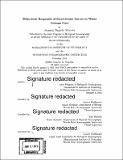Behavioral responses of invertebrate larvae to water column cues
Author(s)
Wheeler, Jeanette Danielle
DownloadFull printable version (13.83Mb)
Other Contributors
Woods Hole Oceanographic Institution.
Advisor
Lauren Mullineaux and Karl Helfrich.
Terms of use
Metadata
Show full item recordAbstract
Many benthic marine invertebrates have two-phase life histories, relying on planktonic larval stages for dispersal and exchange of individuals between adult populations. Historically, larvae were considered passive drifters in prevailing ocean currents. More recently, however, the paradigm has shifted toward active larval behavior mediating transport in the water column. Larvae in the plankton encounter a variety of physical, chemical, and biological cues, and their behavioral responses to these cues may directly impact transport, survival, settlement, and successful recruitment. In this thesis, I investigated the effects of turbulence, light, and conspecific adult exudates on larval swimming behavior. I focused on two invertebrate species of distinct morphologies: the purple urchin Arbacia punctulata, which was studied in pre-settlement planktonic stages, and the Eastern oyster Crassostrea virginica, which was studied in the competent-to-settle larval stage. From this work, I developed a conceptual framework within which larval behavior is understood as being driven simultaneously by external environmental cues and by larval age. As no a priori theory for larval behavior is derivable from first principles, it is only through experimental work that we are able to access behaviors and tie them back to specific environmental triggers. In this work, I studied the behavioral responses of larvae at the individual level, but those dynamics are likely playing out at larger scales in the ocean, impacting population connectivity, community structure, and resilience. In this way, my work represents progress in understanding how the ocean environment and larval behavior couple to influence marine ecological processes.
Description
Thesis: Ph. D., Joint Program in Biological Oceanography (Massachusetts Institute of Technology, Department of Biology; and the Woods Hole Oceanographic Institution), 2016. Cataloged from PDF version of thesis. Includes bibliographical references (pages 139-150).
Date issued
2016Department
Joint Program in Biological Oceanography.; Woods Hole Oceanographic Institution; Massachusetts Institute of Technology. Department of BiologyPublisher
Massachusetts Institute of Technology
Keywords
Joint Program in Biological Oceanography., Biology., Woods Hole Oceanographic Institution.